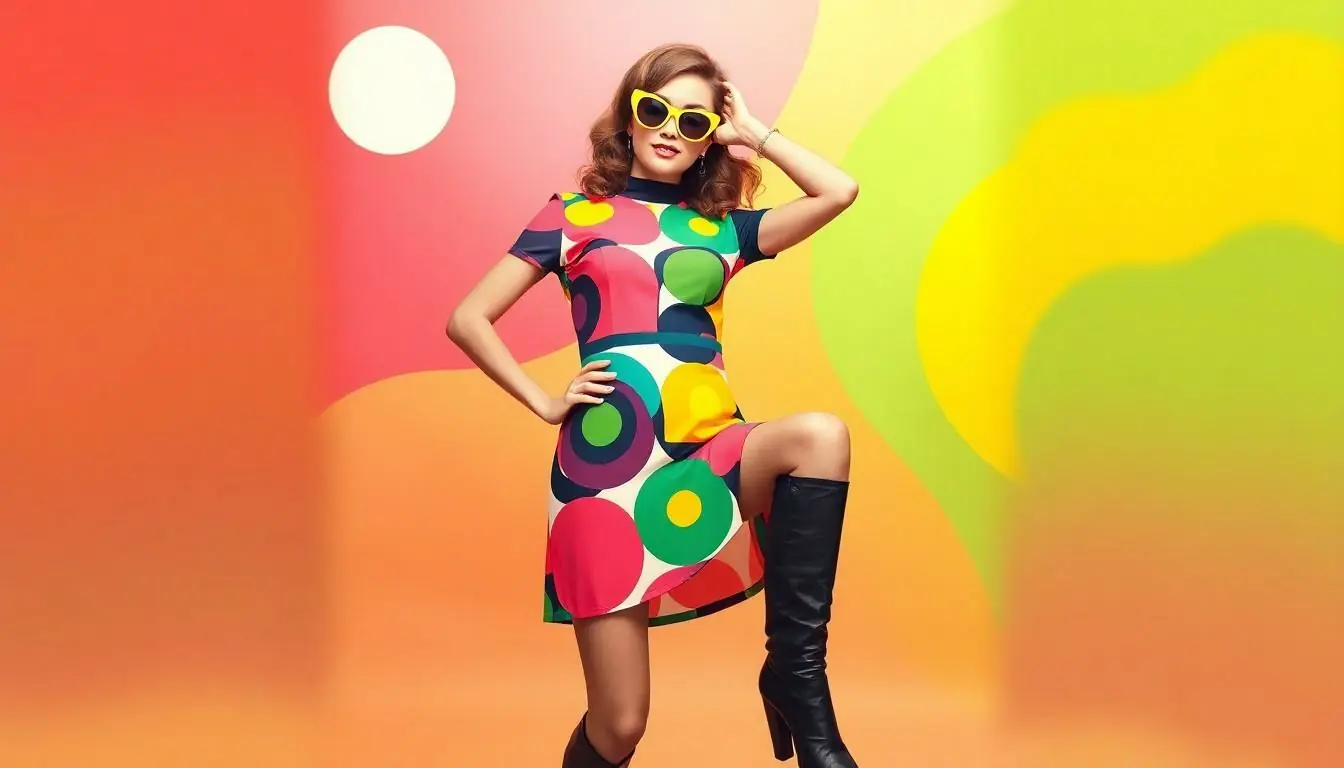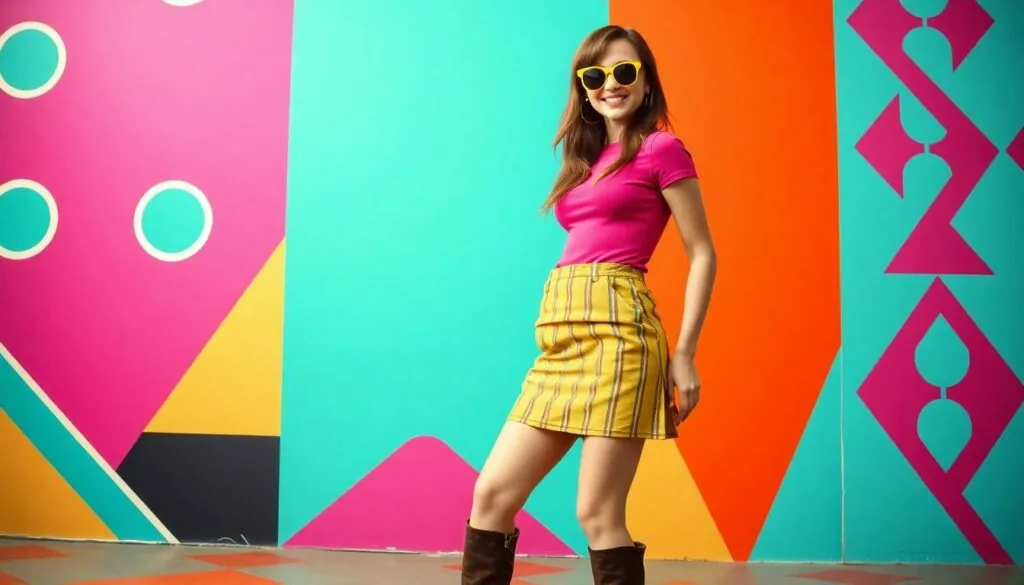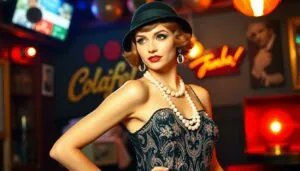Step back in time to the fabulous 1960s, where women’s fashion was as bold and vibrant as the decade itself. From the iconic miniskirt that turned heads to the psychedelic patterns that made every outfit a statement, this era was all about breaking the mold. It’s hard not to admire the fearless spirit of women who embraced their individuality and styled their lives with flair.
Table of Contents
ToggleOverview of Women’s 60s Fashion
Women’s fashion in the 1960s embraced boldness and creativity. The miniskirt emerged as a defining garment, introduced by designer Mary Quant, symbolizing women’s liberation and a break from traditional norms. Psychedelic patterns flourished, featuring vibrant colors and abstract designs that captured the era’s sense of freedom.
Iconic styles blended influences from various movements. Mod fashion became prominent, with fitted dresses and geometric shapes highlighting youthful exuberance. The introduction of the A-line silhouette provided a fresh look, allowing women to express their individuality.
Accessories played a crucial role in completing outfits. Chunky jewelry, oversized sunglasses, and knee-high boots became staples that complemented various clothing styles. The use of bold makeup, including vibrant eyeshadows and mod eyeliner, enhanced the overall aesthetic.
Fashion icons such as Twiggy and Jean Shrimpton set trends that resonated with many women. Their influence extended beyond clothing to hairstyles, with pixie cuts and long flowing locks becoming widely popular. This era also saw the rise of brands like Mary Quant and André Courrèges, changing the landscape of women’s fashion.
The 1960s showcased women’s desire to break boundaries through clothing choices. Each outfit reflected personality and spirit, forming a lasting legacy in fashion history. Innovative designs and fearless choices defined the decade, inspiring future generations to embrace their unique styles.
Key Trends of the Era

The 1960s featured diverse fashion trends that defined women’s styles and showcased their independence.
The Mod Style
Mod style emerged as a dominant force in 1960s fashion. Characterized by bold colors and geometric patterns, this look often included sharply tailored clothing. Fitted dresses became staples paired with knee-high boots or go-go shoes. Accessories played a significant role, with chunky jewelry and oversized sunglasses enhancing the visual impact. Designers like Pierre Cardin and Mary Quant became synonymous with this trend, reflecting youthful energy and rebellious spirit. Women wearing mod clothing conveyed an image of confidence and modernity, shaping the cultural landscape of the time.
Bohemian Influences
Bohemian influences offered a contrast to the structured mod style. Flowing fabrics and intricate patterns characterized this trend, allowing for personal expression. Long skirts and loose blouses became popular choices among women seeking comfort and artistic flair. Patterns often featured bright colors, embroidered details, and ethnic designs, reflecting a global perspective. Iconic figures like Janis Joplin embodied this aesthetic, promoting a carefree, free-spirited attitude. The combination of eclectic styles and bold accessories transformed the way women expressed their individuality during the decade.
Iconic Designers and Brands
The 1960s featured influential designers who shaped women’s fashion during the decade. Their contributions reflected the era’s spirit of innovation and liberation.
Mary Quant
Mary Quant emerged as a leading figure in the 1960s fashion scene. She introduced the miniskirt, a groundbreaking garment that symbolized women’s liberation and changed how women dressed. Quant’s bold use of color and playful patterns resonated with the youth of the time. Her designs emphasized freedom, comfort, and self-expression, pushing women to embrace their individuality. Quant’s boutique, Bazaar, became a hub for the mod style, drawing fashion-forward individuals eager to adopt her unique aesthetic. Innovations in fabrics further distinguished her work, leading to a lasting impact on the fashion industry.
André Courrèges
André Courrèges revolutionized fashion with his futuristic approach. He popularized the A-line silhouette, which offered a modern twist on femininity. Courrèges embraced geometric shapes and minimalism, giving women a chic, youthful look. His designs often featured bold colors and clean lines that exuded confidence and sophistication. Accessories like go-go boots became synonymous with his collections, seamlessly blending style and practicality. Courrèges’ vision not only defined the mod movement but also paved the way for future designers, leaving a legacy of innovation that continues to influence today’s fashion landscape.
Important Fashion Pieces
The 1960s featured various fashion staples that defined women’s styles. Each piece contributed to a vibrant and expressive wardrobe.
Mini Skirts
Mini skirts captivated women during the decade, symbolizing liberation and youthful exuberance. Introduced by Mary Quant, this daring length reshaped traditional concepts of femininity. Skirts often ended well above the knee, allowing for bold movement and confidence. Women paired them with knee-high boots or stylish flats, enhancing their modern aesthetic. The miniskirt emerged as a statement piece, embraced by various subcultures, from mod to rock. Its popularity redefined societal norms and encouraged self-expression, making it a central element of 60s fashion.
Shift Dresses
Shift dresses gained widespread acclaim during this era, characterized by their simple, A-line silhouettes. These dresses flattered diverse body types, making them versatile and approachable. Celebrities often showcased them in vibrant prints or solid colors, embodying the optimistic spirit of the time. The ease of movement highlighted their practicality, appealing to working women and the casual lifestyle emerging in the 60s. Paired with statement accessories, shift dresses became a canvas for individual style, showcasing bold patterns and textures that resonated widely.
Cultural Impact of Women’s 60s Fashion
Women’s fashion in the 1960s significantly influenced societal norms. The introduction of the miniskirt served as a powerful statement of liberation, allowing women to express individuality and challenge traditional constraints. Designers like Mary Quant played a pivotal role in shaping this movement, making bold choices that resonated with the spirit of the times.
The mod fashion trend, marked by tailored designs and vibrant colors, highlighted a youthful and confident approach to personal style. Pierre Cardin’s innovative use of geometric shapes contributed to this aesthetic, making stark lines a symbol of modernity. Women embraced these styles as expressions of their evolving roles in society, shifting toward more assertive identities.
Bohemian influences also made a notable impact, with flowing fabrics and intricate patterns encouraging personal expression. Janis Joplin became an icon of this free-spirited ethos, influencing countless women to adopt a similar carefree attitude in their fashion choices. This blend of eclectic styles transformed wardrobes, allowing for unprecedented self-expression.
The legacy of 1960s fashion extends beyond clothing. Iconic figures like Twiggy and Jean Shrimpton shaped not only trends in attire but also hairstyles and makeup, inspiring generations to come. The bold use of accessories, such as oversized sunglasses and chunky jewelry, complemented these styles, enhancing the confidence of those who wore them.
Overall, the 1960s marked a turning point in how women viewed fashion and their identity, emphasizing self-exploration and empowerment through personal style. Fashion in this decade remains a vital reference point, motivating new interpretations in modern design.
The fashion of the 1960s remains a powerful testament to women’s liberation and self-expression. This vibrant decade not only reshaped clothing styles but also redefined societal norms. From the daring miniskirt to the flowing bohemian looks, each trend encouraged women to embrace their individuality.
The influence of iconic designers and fashion figures continues to resonate today, reminding us of the bold choices that paved the way for future generations. As contemporary fashion draws inspiration from this era, the spirit of the 1960s lives on, celebrating creativity and confidence in personal style.




